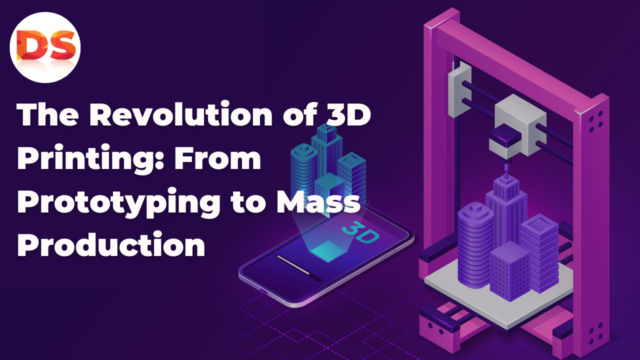The Evolution of 3D Printing: From Prototypes to Mass Production
Introduction
Lately, the manufacturing field has gone through a colossal revolution goaded by striking advancements in 3D printing technology. Suggested as additive manufacturing, 3D printing has outperformed its initial explanation only for rapid prototyping and has emerged as a functional technique for huge-scale production. This article means to plunge into the evolutionary bearing of 3D printing, exploring its new development, the evolution of additive manufacturing, and the reasonable repercussions for the future of industrial production.
3D Printing Evolution
The inception of 3D printing can be followed back to the mid 1980s when Throw Plan, the coordinator behind 3D Plans, made stereolithography, the immense business 3D printing technology. All through the immense length, 3D printing has passed using a specialty technology on to a distinct advantage in the manufacturing landscape. The evolution of 3D printing can be assembled into a few stages, each certain by beast advancements in technology, materials, and applications.
Initially, 3D printing was fundamentally utilized for creating models, allowing engineers and coordinators to test and emphasize their plans more rapidly than standard approaches. As the technology made, it expanded past prototyping into different industries, paving the way for additive manufacturing to redefine production processes.
Additive Manufacturing Progress
The adage “additive manufacturing” reflects the fundamental principle behind 3D printing — building objects layer by layer. This additive philosophy has been demonstrated to be an undeniable takeoff from subtractive manufacturing systems, where the material is eliminated to make the final thing. The progress in additive manufacturing has been driven by innovations in materials, printing technologies, and the headway of more refined printing gear.
Additive manufacturing has become inseparable from productivity, squander decrease, and increased plan opportunity. Customary manufacturing processes often produce significant waste material, while 3D printing takes into account exact testimony of material, minimizing waste. The progress in additive manufacturing has likewise seen the development of viable materials, from plastics and metals to pottery and even bioinks for clinical applications.
Prototyping with 3D Printing
In its initial stages, 3D printing found prominent early use in the domain of speedy prototyping. Engineers and planners could rapidly transform their advanced plans into indisputable models, facilitating faster accentuation and reducing improvement cycles. The ability to make complex estimations and intricate plans with ease made 3D printing an invaluable instrument for prototyping across industries.
The progress of rapid prototyping technology speeds up the thing progress process as well as particularly diminishes the expenses linked to show production. Standard prototyping techniques often involve work-intensive and past over the top processes like CNC machining or injection molding. Obviously, 3D printing awards on-demand prototyping, empowering originators to rapidly and cost-decidedly execute changes.
3D Printing Advancements
Advancements in 3D printing technologies play had a crucial impact in its evolution. From stereo lithography to explicit laser sintering and consolidated clarification modeling, different printing techniques have arisen, each with its assets and applications. Rapid continuous 3D printing, multi-material printing, and further made accuracy are among the outstanding advancements that have expanded the restrictions of 3D printing.
Materials have in like manner gone through basic advancements, with an increasing show of decisions open for 3D printing, including advanced polymers, metals, stoneware, and even biomaterials. These advancements have opened up extra open doors for applications ranging from flying parts to modified clinical inserts.
Rapid Prototyping Technology
Rapid prototyping has become inseparable from 3D printing, and the technology continues to progress to fulfill the necessities of present day thing improvement cycles. The integration of man-made brainpower and machine learning has enabled judicious modeling, optimizing the prototyping framework and reducing the prerequisite for expansive testing.
Furthermore, the combination of 3D printing with various technologies, similar to 3D scanning and PC produced reality, has worked with a more exhaustive method for dealing with rapid prototyping. This intermingling of technologies considers a reliable change from the virtual arrangement stage to genuine models, streamlining the thing improvement lifecycle.
Industrial 3D Printing Growth
The improvement of industrial 3D printing has been colossal, as different locales integrate the technology for both prototyping and production purposes. Exceptionally, the flight and vehicle industries have vigorously taken on 3D printing by virtue of its ability to make lightweight and intricate parts, enhancing in ordinary performance and eco-friendliness.
The clinical field has furthermore seen goliath growth in the utilization of 3D printing for producing patient-unequivocal inserts, prosthetics, and even organs. The customization offered by 3D printing lines up with the model toward re-tried and patient-driven clinical idea plans.
Additive Manufacturing Trends
The trends in additive manufacturing are indicative of the technology’s development and acknowledgment across industries. One striking pattern is the increasing reception of 3D printing for end-use production parts. While the technology initially gained prominence for prototyping, its dependability and material advancements have prepared for the immediate production of final parts.
A common pattern involves incorporating 3D printing consistently into laid-out manufacturing work processes. Businesses are effectively investigating the combination of customary manufacturing techniques with 3D printing to outfit the benefits offered by every strategy. This half and half manufacturing technique introduces adaptability, enabling the choice of the most proper methodology for explicit parts or production necessities.
3D Printing Innovation
Ongoing innovation in 3D printing is a powerful cycle, with specialists and organizations reliably pushing the constraints of the technology’s capacities. The continuous evolution of printing techniques, materials, and post-processing strategies effectively upgrades the flexibility and relevance of 3D printing across a wide cluster of industries.
One area of innovation is the progress of speedy, immense-scale 3D printing frameworks. These frameworks intend to address the speed hindrances of normal 3D printing techniques, making the technology more workable for mass production. Innovations in multi-material printing and collection limits besides updating the rich and feasible likely aftereffects of 3D-printed things.
Mass Customization in Manufacturing
An outstanding result of 3D printing’s evolution is the ascent of mass customization in manufacturing. Conventional mass production strategies often depend on economies of scale, producing huge amounts of indistinguishable items to accomplish cost productivity. In any case, 3D printing considers the practical customization of items, catering to individual inclinations and necessities.
Mass customization is especially obvious in industries like footwear, where 3D printing empowers the making of customized and definitively fitting shoes. In the auto area, redid parts and interiors can be delivered on demand, offering purchasers a remarkable and custom-made insight.
Future of 3D Printing
Looking forward, the future of 3D printing holds gigantic responsibility and potential. As technology continues to impel, a couple of key districts should shape the heading of 3D printing in the coming years.
One huge angle is the ongoing mission for quicker and more adaptable 3D printing processes. Analysts are exploring novel methodologies, like continuous fluid interface production (CLIP) and high velocity sintering, to conquer the speed limits of conventional layer-by-layer techniques. These advancements will assume a vital part in making 3D printing more serious than conventional manufacturing techniques for enormous scale production.
Prototyping Revolution
The prototyping revolution achieved by 3D printing has sped up item improvement cycles as well as encouraged a culture of innovation. Planners and engineers can investigate seriously daring and capricious plans without the constraints forced by customary prototyping techniques. The iterative idea of 3D printing considers rapid testing and refinement, pushing the limits of what is conceivable in item plan.
Moreover, the prototyping revolution has democratized admittance to item advancement. Little new businesses and individual inventors can now affordably model their thoughts, leveling the playing field in the innovation landscape. This openness has brought about a flood of innovativeness and pioneering movement, with individuals and private ventures contributing to a more different and energetic market.
Additive Manufacturing Processes
The assortment of additive manufacturing processes adds to its flexibility across industries. Specific laser sintering (SLS), stereolithography (SLA), and merged affirmation modeling (FDM) are among the profoundly grounded processes, each offering exceptional advantages and sensible applications. Continuous advancements in these processes and the improvement of new ones further expand the possible results of additive manufacturing.
Processes like mechanized light processing (DLP) and binder jetting have gained a traction for their speed and cost-feasibility. DLP, explicitly, thinks about significant standard printing and is proper for applications, for instance, dental and diamonds manufacturing. As the additive manufacturing landscape continues to grow, new processes are likely going to emerge, addressing express industry needs and pushing the restrictions of what is possible.
Conclusion
The transformative outing of 3D printing, starting from its simple roots in prototyping to its ongoing situation as a revolutionary force in mass production, includes the adaptability and flexibility of this groundbreaking technology. Additive manufacturing has investigated through various stages, coordinated by advancements in printing techniques, materials, and an expanding familiarity with its capacities.
The revolution in rapid prototyping technology has streamlined the thing progress cycle as well as pushed innovation, democratizing authorization to the prototyping structure. The industrial rising of 3D printing, its different applications spanning different areas, and the ongoing trends in additive manufacturing underscore the technology’s pertinence and concealed limit.








